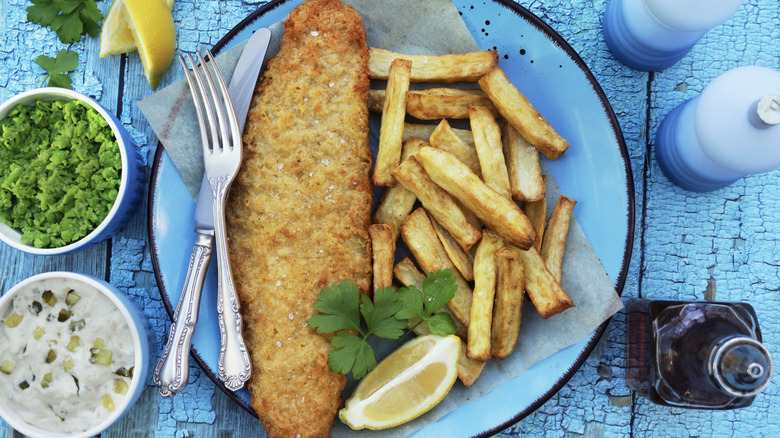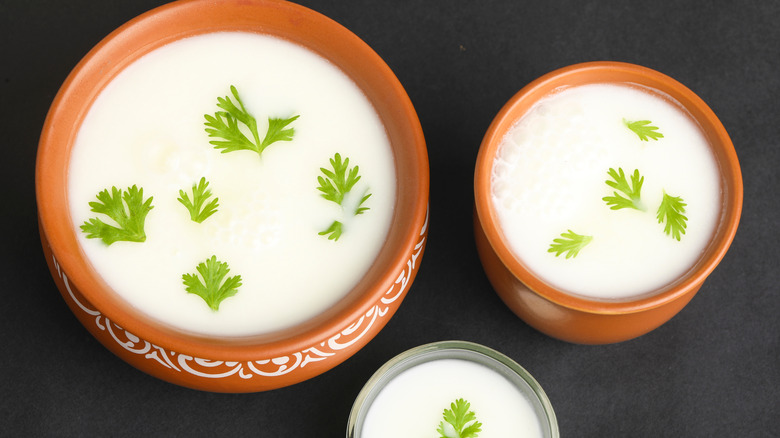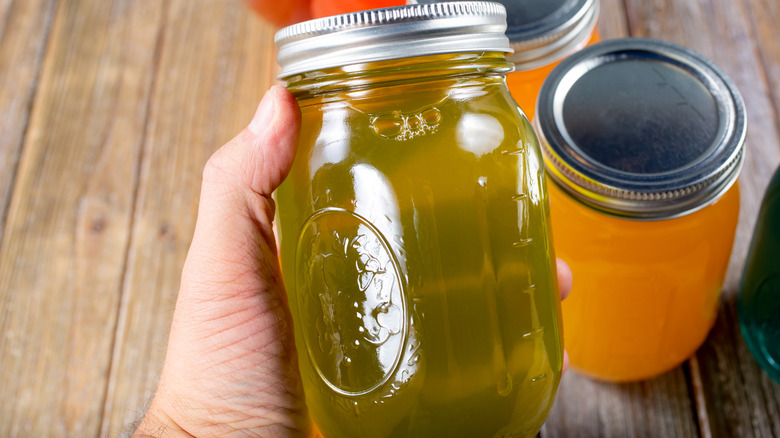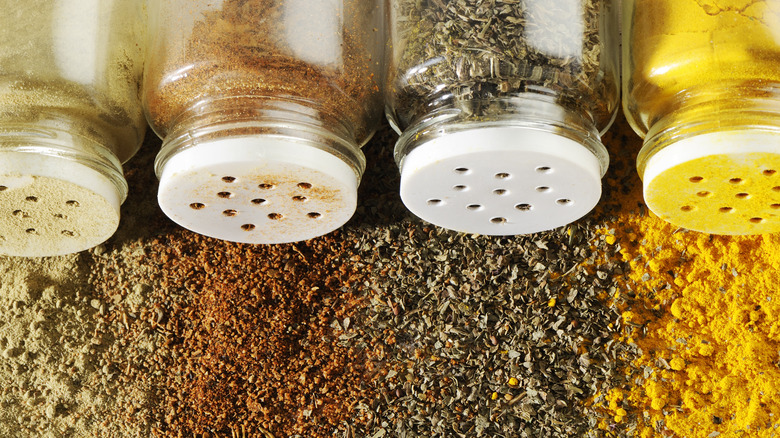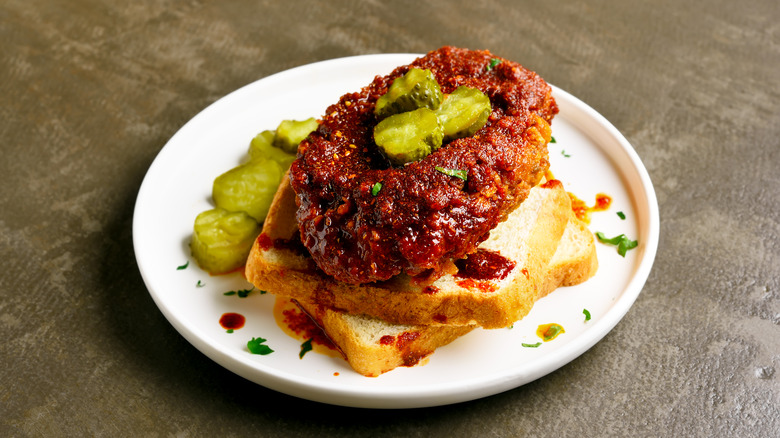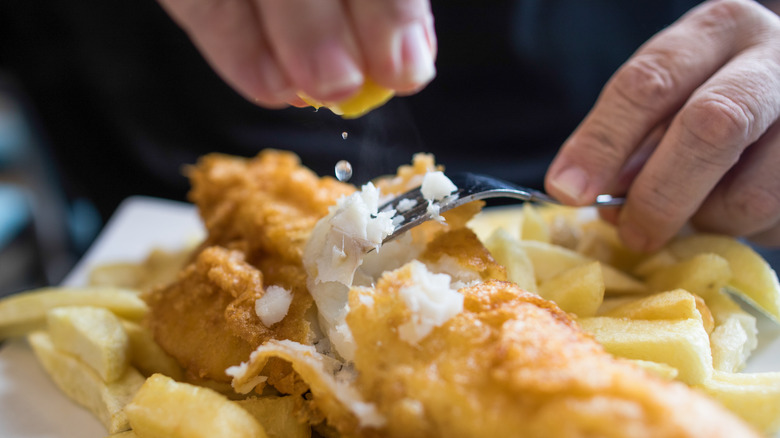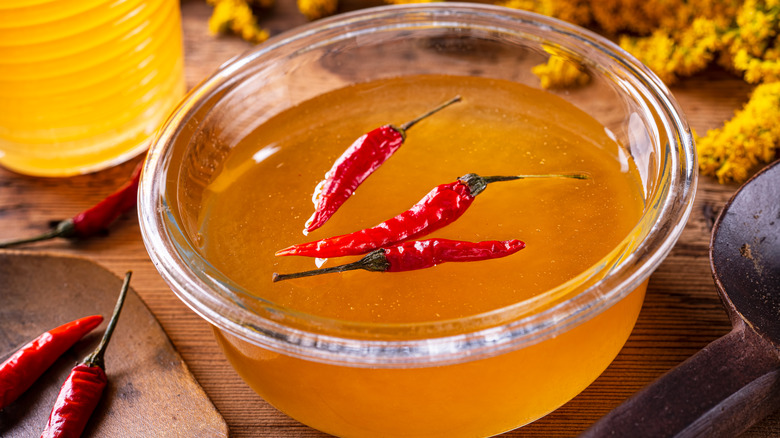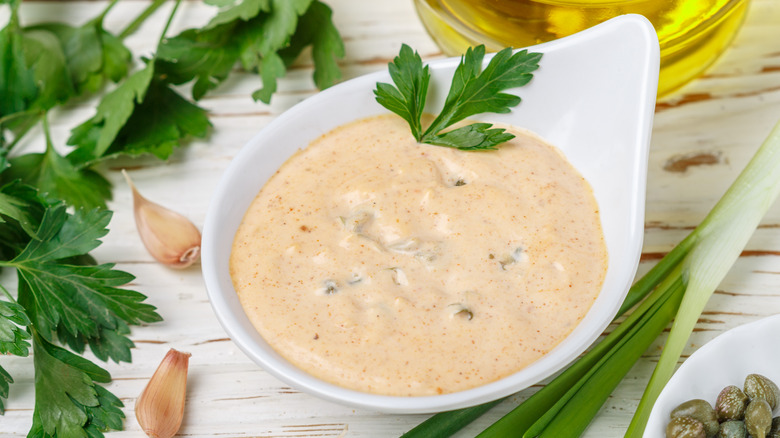10 Ways To Flavor Fried Fish
There's something so appealing about a hunk of fish nested in a wrapping of wax paper with cups of dipping sauce and tantalizing sides. Fried fish can take many different forms, from the traditional British basket of crispy golden cod with wedge potatoes to spicy crunchy catfish served with chow chow and okra. No matter what version of the dish you're looking to sizzle up, it's essential to infuse as much flavor as possible into the fish, batter, breading, and even dipping sauces as possible to prevent your fish from tasting bland and greasy. Luckily, there are many easy ways to boost the flavor of your fried fish, and you probably already have most of the ingredients you need in your pantry or fridge.
Embarking on a dinner of fried fish requires a little bit of planning and prep work, but you'll find that the extra steps will be more than worth it when you taste just what a difference they make with your fish. You want to make sure that you're using a firm white fish such as haddock, cod, catfish, or flounder. These lean, flakey varieties hold up best with the high heat from the oil. Once you have your blank fishy canvas, you're ready to get creative.
Soak fish in buttermilk
Fried fish shares a lot in common with another popular fried favorite: chicken. Both meats benefit from the addition of flavor before they're cooked, and a bit of acid goes a long way toward tenderizing and adding moisture before the meat hits the heat. Buttermilk brines break down tough proteins in meat and help hold in the natural moisture that keeps the meat from drying out during the frying process.
Naturally acidic, buttermilk has a tangy flavor that can stand on its own, or you can add additional spices to it such as paprika, white pepper, cumin, or garlic. These flavors will infuse into the fish as it marinates in the buttermilk and ensures that every bite of fish has plenty of kick. Because fish is more delicate than chicken, you don't want it to marinate for too long. An hour or two submerged in the buttermilk marinade in the fridge is plenty of time for the buttermilk to work its magic.
Marinate fish in pickle juice
If you're anything like us, pickles are a way of life, and you have at least one jar in the fridge that is almost totally void of lovely crunchy pickles, but mostly full of the liquid gold that is pickle brine. Once again, we'll take a cue from the school of fried chicken and recommend using that pickle brine as a marinade for your fish.
With its acidic vinegar base, pickle juice makes an excellent marinade. It is loaded with spices, herbs, and that lingering cucumber goodness, so you hardly need to doctor it up at all. You can use it on its own or combine it with buttermilk to make a double-whammy of a flavor bath that will imbue your fish with layers of deliciousness that will permeate every bite. Don't let your pickle juice go to waste by dumping it down the drain; put it to work making your fried fish unforgettable.
Make a curried yogurt marinade
A final marinating suggestion, try making a spiced yogurt marinade, specifically a flavorful curry with a yogurt base. There are many benefits of using yogurt as a marinade. Much like buttermilk, yogurt is acidic and full of beneficial enzymes and bacteria that penetrate through meat and flavor it from the inside out. The creamy nature of yogurt helps thoroughly coat the fish and introduce whatever seasonings you mix into it.
Yogurt marinades are especially popular in Indian cuisine, so try using some of the bright, bold spices from that flavor wheel to give your fish a distinctive flair before it hits the batter. The light flavor of most flakey white fish that is best for frying is a great canvas for letting the unmistakable taste of your favorite curry blend shine. Infusing the curry into the fish as opposed to the batter will give your dish a brightened and layered taste profile and the yogurt marinade keeps the fish from drying out while it is cooking.
Switch out your breadcrumbs for cornmeal
If you're pan-frying your fish, you might be used to just dredging the filets in flour or maybe some breadcrumbs to give them the crunchy coating. However, you might want to trade in your basic breadcrumbs for some yellow or white cornmeal to give your fish the crispiest coating. Most often found on catfish, cornmeal breading is a hallmark of Appalachian and Cajun cuisine. The texture of cornmeal is courser than your standard breadcrumbs, and when it is fried in oil, it becomes shatteringly crisp. It also adds a delectable sweetness that plays so nicely with the mild fish flavor.
Cornmeal can be seasoned with basic salt and pepper, or you can kick up the heat by dusting in some cayenne pepper before you dredge the fish in it. This crunchy coating is best suited for shallow or pan-fried fish. You don't need too much oil to get the right consistency with cornmeal breading, and it cooks up quickly. It's the perfect solution for a summer fish fry.
Use a Cajun spice blend in the batter
Speaking of Cajun influences, New Orleans flavors are made for seafood. Though Cajun cuisine might more readily call to mind gumbo, jambalaya, or étoufée, all of which are shellfish-centric, catfish and cod frequently take center stage in many Cajun dishes. These fish are excellent for frying, so why not give them the old Louisiana flair? It's super easy to throw together a Cajun spice blend with ingredients that you most likely already have in your spice rack. The prevailing flavors of paprika, oregano, garlic, and thyme are robust enough to hold their own in a fried fish batter or breading.
Instead of traditional chips, serve your Cajun fish fry with hushpuppies, okra, chow chow, or collard greens. You can even sprinkle the Cajun spice blend into your standard tartar sauce to give it an extra twist of flavor. You might find yourself adding this spice combo to just about everything from now on.
Include a strong beer in the batter
Battered fried fish is different from dredged fish. With dredged fish, you're dipping your fish into an egg mixture, then a flour and breadcrumb coating before it's fried. With battered fish, you mix up a wet batter that you dip your floured fish into before dropping it into the hot oil. Both techniques yield crispy exteriors, but the battered fish tends to be a puffy, crunchy jacket of golden joy.
Using beer in your batter is what gives the mixture its lightness, thanks to the carbonation found in the brew. It also lends a distinctive malty flavor to your dish. Most of the time, people opt for lighter beers, like pilsners or lagers to mix into their batters. However, if you wanted to bring some serious flavor to your fish try branching out in your beer selection. IPAs, ales, and bitters are varieties of beer that have a pronounced flavor that will give your fish an extra edge. You can use the batter to make onion rings, fried pickles, and fried zucchini sticks as well to accompany your fish.
Nashville hot chicken oil will spice things up
A basket isn't the only vehicle for fried fish. You can make a killer sandwich with a slab of fried fish, some slaw, some sauce, and a soft, buttery roll. It's a fun and casual way of serving your fish and opens a lot of options for variations. Another famous fried sandwich filler is a national treasure: the Nashville hot chicken. This regional delicacy is sticky, delicious, and spicy, all excellent elements when you're going for a fun twist on a standard fried fish sandwich.
The key to a Nashville-style hot fish sandwich lies in the spicy chili oil. A blend of cayenne pepper, smoked paprika, cumin, and sugar is steeped in warm oil, imbuing it with its flavors. You can drizzle this warm oil blend over your crispy fried fish before topping it with some slaw or pickles. The oil will permeate the crunchy coating of the fish and you'll be considering a new white meat as the king of Nashville.
Squeeze citrus on hot fish as soon as it comes out of the oil
There is nothing wrong with keeping things simple. Forget all the spices and the toppings. Sometimes you want to bring everything down to the basics. In this case, you might just be looking for the clean taste of salt and citrus. Lemon and fish are as inseparable as salt and pepper. The bite of citrus heightens and defines the mild flavor of flakey white fish.
By squeezing the lemon juice onto the hot fish right when it comes out of the frying oil, the citrus flavor is captured in the food as it cools. The scent of lemon will mingle with the steam and get your senses ready to enjoy your meal. You should also sprinkle some kosher salt onto the fish while it's still hot; this allows the salt crystals to stick to the coating as it cools. The proper timing is just as important as the proper seasoning, but neither of them needs to be overly complex. Salt and lemon right on hot fried fish will bring out all the right notes.
Drizzle a finishing of hot honey or maple syrup for a pop of sweetness
Sometimes playing with diametrically opposing flavors can yield fantastic and unexpected results. Take, for example, the phenomenon of hot honey. Hot honey is golden amber honey that has been infused with the heat of chilis. It's a memorable topping for cornbread, chicken, and yes, even fried fish. The spicy sweetness is a great highlight to the salty crunch of the battered or breaded fish.
If you aren't super keen on additional heat, you can keep the sweetness by just using plain honey or even pure maple syrup. You don't need too much of either of these toppings, as they are both ultra-sweet. A tiny drizzle right over the top of your hot fried fish will give a delightful, sweet, depth of flavor that is utterly unique and unexpected. You might even think about creating a new "brinner" dish: fried fish and cornbread waffles.
Replace your standard tartar sauce with a kicky remoulade
Almost every fried seafood dish comes with a side of tangy tartar sauce. It almost feels like a sin to eat fried seafood without it. But tartar sauce has a sassy sister; remoulade sauce. What's the difference between the two? The short answer is whatever you think to add. Remoulade sauce is sort of a catch-all term for a creamy, mayonnaise- or yogurt-based dipping or spreading sauce.
Tartar sauce derives the majority of its flavor from chopped pickles or capers mixed into a creamy base. Remoulade sauce can include horseradish, mustard, shallots, and in the case of Louisiana remoulade, hot sauce. So if you want to add more of a kick to your fish and chips, mix up a remoulade of your own, or you can use store-bought tartar sauce as a starting base and shake in a few drops of hot sauce, a dollop of mustard, or a helping of Worcestershire sauce. Heck, make several variations and set yourself up with a sauce station with lots of different options.
